|
Renault Twingo II
Debut: 2007
Maker: Renault
Predecessor: Twingo I
|
|
 The original
Twingo was a classic example
that innovative designs sell themselves. Born in 1993, the Twingo was
famous for a trend-setting monospace design, which looked funky and
provided a roomy cabin, and a sliding rear seat, which allowed flexible
distribution between passenger room and luggage room. Both features
were widely copied from other car makers. The Twingo offered only one
body style and limited choices of engines and trims, but it still sold
2.4 million copies in the following 14 years, which was quite a
miracle. Not many cars could survive for more than 10 years, even fewer
could match the Twingo. Renault did want to replace it earlier, but
unfortunately it found the modern requirements for crash protection and
clean emission could eat heavily into the already slim profit of the
little car. To make sure the new car earn money for Renault, group CEO
Carlos Ghosn turned down an earlier proposal and ordered the engineers
to develop a cheaper one, which is this one. The original
Twingo was a classic example
that innovative designs sell themselves. Born in 1993, the Twingo was
famous for a trend-setting monospace design, which looked funky and
provided a roomy cabin, and a sliding rear seat, which allowed flexible
distribution between passenger room and luggage room. Both features
were widely copied from other car makers. The Twingo offered only one
body style and limited choices of engines and trims, but it still sold
2.4 million copies in the following 14 years, which was quite a
miracle. Not many cars could survive for more than 10 years, even fewer
could match the Twingo. Renault did want to replace it earlier, but
unfortunately it found the modern requirements for crash protection and
clean emission could eat heavily into the already slim profit of the
little car. To make sure the new car earn money for Renault, group CEO
Carlos Ghosn turned down an earlier proposal and ordered the engineers
to develop a cheaper one, which is this one.
Sadly, in this case cheaper means more conventional. Renault plays safe
this time, sacrificing the trademark monospace design for a
conventional two-box shape. Admittedly, a longer nose copes better with
crash test. Although Patrick le Quement's design team gave it a pretty
elegant and upmarket front end design, the new Twingo has lost the
magic of the original car and looks hardly outstanding in the sea of
sub-minis. As before, 3-door is the only body style on offer in order
to save costs. Other cost saving measures include sharing most
underpinnings (suspensions, most engines and gearboxes) with the old
Clio II and build together with Clio II in the Slovenia factory to take
advantage of lower labor costs.
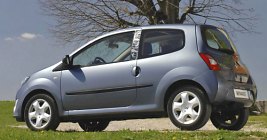 The new Twingo is slightly larger than Fiat Panda and more
so than Toyota Aygo / Peugeot 107 / Citroen C1, all are its key rivals
in Europe. Fortunately, it also offers more interior room than them.
The front seats offer good head and knee room. The rear are two
individual seats which can slide fore and aft for a range of 22 cm. In
the rearmost position, they offer ample legroom for 6-foot-plus
passengers, although the headroom is not so generous. Slide the seats
forward and the boot increases to a remarkable 285 liters. If that's
not enough, flip the rear seats and it can swallow 959 liters of
luggage. Long items can be accommodated once the front passenger seat
back folds down. Twingo still shines in packaging and cabin
flexibility. The new Twingo is slightly larger than Fiat Panda and more
so than Toyota Aygo / Peugeot 107 / Citroen C1, all are its key rivals
in Europe. Fortunately, it also offers more interior room than them.
The front seats offer good head and knee room. The rear are two
individual seats which can slide fore and aft for a range of 22 cm. In
the rearmost position, they offer ample legroom for 6-foot-plus
passengers, although the headroom is not so generous. Slide the seats
forward and the boot increases to a remarkable 285 liters. If that's
not enough, flip the rear seats and it can swallow 959 liters of
luggage. Long items can be accommodated once the front passenger seat
back folds down. Twingo still shines in packaging and cabin
flexibility.
The cabin has plenty of storage cubbies and some upmarket optional
kits, such as i-Pod and Bluetooth connectivity, a panoramic glass roof
and even a cruise control. However, it has none of the upmarket feel
that other Renault models delivered. The hard plastic dashboard is
uninspiring. The centrally mounted instrument is hard to like. The
conventionally located gearstick is not as convenient to use as the
dash-mounted one found in Fiat Panda. Sometimes style and colors may
compensate the lack of quality, but Twingo has none of them.
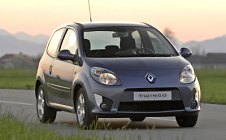 Like most other mini cars, Twingo rides on strut and
torsion-beam suspensions, steer through a rack-and-pinion system with
electric assistance and find power from a transversely mounted
4-cylinder engine driving the front wheels. Most engines are cheap and
well proven in the old Clio, such as the 60hp 1.2-liter 8V, 75hp
1.2-liter 16V and 65hp 1.5dCi turbo diesel. The only new engine, also
the most interesting, is the 1.2 TCE (Turbo Control Efficiency) engine.
It is based on the 1.2-litre 16V but added with a light-pressure
turbocharger to produce 100 horsepower and 107 lbft of torque. A small
overboost can take the output to 105hp and 111 lbft in case of need. Like most other mini cars, Twingo rides on strut and
torsion-beam suspensions, steer through a rack-and-pinion system with
electric assistance and find power from a transversely mounted
4-cylinder engine driving the front wheels. Most engines are cheap and
well proven in the old Clio, such as the 60hp 1.2-liter 8V, 75hp
1.2-liter 16V and 65hp 1.5dCi turbo diesel. The only new engine, also
the most interesting, is the 1.2 TCE (Turbo Control Efficiency) engine.
It is based on the 1.2-litre 16V but added with a light-pressure
turbocharger to produce 100 horsepower and 107 lbft of torque. A small
overboost can take the output to 105hp and 111 lbft in case of need.
On the road, the Twingo feels surprisingly refined for a small car. Its
suspensions are especially absorbent, like traditional French cars. The
cabin is well insulated from tire and wind noise. Its steering is
precise and well weighted, if short of feel. It corners competently but
you can't call it an entertaining drive. The normally aspirated engines
aren't as refined as Fiat's and they struggles to cope with the heavier
weight of Twingo – some 65kg heavier than Panda and 135kg more hefty
than Aygo. Therefore performance is modest.
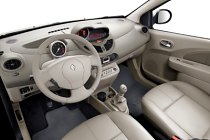 In contrast, the 1.2 TCE's turbo engine is torquey and
flexible. It pulls like a 1.6-liter engine but returns lower fuel
consumption. The problem is, Renault sells it as a hot hatch and
targets against Fiat Panda 100HP. Drive it in enthusiastic mode, its
engine feels uninspiring. Once you wind it above 5000 rpm, it sounds
coarse and becomes reluctant to rev. This engine performs best in
motorway cruising. The suspensions, tires and steering of TCE also
lacks the sharp tuning of Panda 100HP. Renault seems reserving the
potential for a Renault Sport model in the future… In contrast, the 1.2 TCE's turbo engine is torquey and
flexible. It pulls like a 1.6-liter engine but returns lower fuel
consumption. The problem is, Renault sells it as a hot hatch and
targets against Fiat Panda 100HP. Drive it in enthusiastic mode, its
engine feels uninspiring. Once you wind it above 5000 rpm, it sounds
coarse and becomes reluctant to rev. This engine performs best in
motorway cruising. The suspensions, tires and steering of TCE also
lacks the sharp tuning of Panda 100HP. Renault seems reserving the
potential for a Renault Sport model in the future…
That said, if you don't mind the weaker base engines, the lack of rear
doors and the slightly higher price than rivals, the new Renault Twingo
could be a perfect mini car for you. Just don't expect the innovative,
cheap and cheerful character of the first generation. The link between
the new and old car is no more than the name. |
| The
above report was last updated on 29 Jun
2007. All Rights Reserved. |
Renault Sport Twingo
|
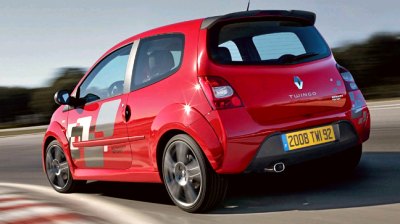
|
It brings back the hot hatch fun we
used to enjoy in the 1980s...
|
The
Renault Sport version of Twingo is very different from its lesser
brother. From outside you can see some aggressive cosmetic mods
including Renault Sport graphics, deep spoilers and extended
wheelarches. The latter made possible to a 60 mm wider track front and
rear. Together with the 10mm reduction of ride height, 30 percent
increase of spring rates and damping stiffness, 25% increase of
anti-roll bar stiffness and quicker steering ratio, it should improve
handling a lot.
In standard form, Renault Sport Twingo is competent enough to rival
most of the junior hot hatches on the market, such as Fiat Panda 100HP.
However, to better than Fiat 500 Abarth, it takes the optional “Cup”
tuning package, which adds another 10 percent stiffness to suspension
and a further 4mm drop in ride height. The stylish alloy wheels also
upgrade from 16 to 17-inch diameter, while lower profile 195/40 tires
take over. In this form, it offers sharper handling than the Abarth in
the price of ride quality. In particular, less roll, less understeer
and more lift-off oversteer to play with. It brings back the hot hatch
fun we used to enjoy in the 1980s (with the exception of steering
feel), yet ultimately it will save your life with ESP. If you can live
with its crashy ride on backroads, it is certainly more entertaining to
drive than the red hot Fiat-Abarth.
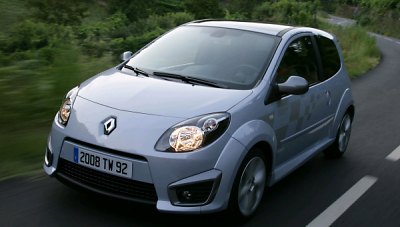
|
Renault Sport's 1.6 engine produces
133 hp, but Honda once managed 185 hp from the same capacity...
|
Unfortunately,
nearly everything else fails to match the high standard of 500 Abarth.
The styling is more boy racer than tasteful. The cabin is still
hopelessly ugly and cheap. Even the new bucket seats and flashy decors cannot improve
things much. The driver seat is still mounted too high for a driver's
car. Worse still, the main instrument readings still locate at the
center console, more like a cheap city car or a family MPV. Is this
really a Renault Sport model ?
The engine is another source of disappointment.
Renault Sport did a lot of works to improve the company’s 1.6-liter 16V
intake variable valve timing engine. It gets 11.0:1 compression, faster
cam profile (longer opening and higher lift), enlarged intake manifolds
and a mean-looking 4-in-1 tuned exhaust system made of stainless steel.
Red line has been raised to 7000 rpm. However, we are neither satisfied
with its 133 horsepower – think about Honda once managed 185ps from the
same capacity in its first Civic Type R - nor the 118 lb-ft of maximum
torque which takes as high as 4400 rpm to realize. The 5 ratios in its
gearbox don’t help to compensate for the lack of low-end grunt. As a
result, you need to work very hard to keep the engine boiling at high
rev. It lacks both the tractability and outright pace of its
turbocharged rivals.
It seems that Renault Sport has done all what it could to improve the
Twingo. It just can't change the fundamental problems of the car. Yes,
it is fun to drive under certain conditions, but its talent is just one
dimensional. |
| The
above report was last updated on 22 Sep
2008. All Rights Reserved. |
|
|